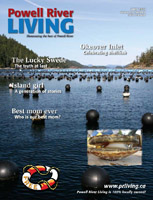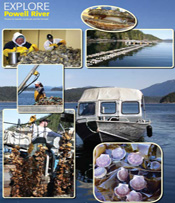May 2009
>> This entire issue is available as a 16MB PDF download
Table of Contents
Gardening the ocean and the land
Kudos
Island life:
Living off the grid on Nelson Island
Wild women cycling
Blast from the Past: Texada's Klondike king
Myrna Leishman scores on seniors' housing stage
Point of VIU: Boating safely
A taste of Okeover
Mother's Day story winner: Why my Mom is the best Mom ever!
For Art's Sake: The classical music scene
TC Mall expansions: Major renovations show commitment
Bruce Denniston Bone Marrow Spirit Run
Tips for the new runner and walker
Business Connections
Patrons promise to promote Powell River:
Festival of Writers set to grow
Time to plant
Pardon My Pen: The inconsistency of English
Family Matters
Faces of Education
Explore Powell River
Gardening the ocean and the land
How many of us would live in or even visit Powell River if it were not for the ocean?
Chances are our city would not even exist were it not for the salt chuck. Its salmon provided food and money for early settlers, and the ease of transporting logs and paper on its surface made the mill here viable. Sadly, the salmon stocks have suffered a serious decline and the forest industry has also taken a beating.
But the ocean remains a life-giving force for our community and nowhere is that more apparent than in Okeover Inlet, where a thriving aquaculture industry pumps millions of dollars in Powell River's economy.
And in a time when food security is increasingly important, the inlet provides a steady supply of seafood to our community and beyond.
In this issue, we take a look at Okeover aquaculture, both through the voices of those gardening in the ocean, and through the lenses of some top-notch photographers. We share some recipes from places in Powell River where you can get locally-grown oysters and other seafood.
We also hear from Marjorie Harding, who has also made a living from shellfish, both farmed and wild. That living allowed her and her family to live a life off the grid in Blind Bay near Nelson Island. Read about the challenges, and rewards of island life.
"Food security" has become a buzzword, but when you say those words, you often see people's eyes glaze over. However, on a practical level, it can simply mean growing your own vegetables and canning some fruit. We're pleased to have talented young gardener Jonathan Van Wiltenburg share some tips on what we should be doing in our gardens during the month of May so we can reap the benefits of fresh produce and savings on our grocery bills.
Many of our advertisers can help you get started in the garden this spring. Not only do they make this magazine possible, but local businesses are happy to help you learn how you can grow at least some of your own food.
Support them and get growing!
Sean Percy, Associate Publisher ¥ sean@prliving.ca
You're never too old to win a gold!
Just ask Volker Pfeifer who won his first gold medal at the BC Open Judo Tour in Vernon on April 11 in the over-35 category.
Although Volker first started judo as a 14-year-old back in Germany, he abandoned it after four years. Then three and a half years ago he met Neil MacKenzie and took it up again. He was 45.
"I enjoyed it so much I got involved. I help teach the Teddy Bear class for four to six year olds and the junior class."
Two years ago Volker began competing. "It was tough in the beginning; most of the competitors were 20 years younger."
Volker says judo is a sport you can do no matter how old or young you are. He points to Sensei Dave who is 68. "It does not have to be competitive. It's a good workout."
You rock Volker!
Doc Hocking wins award
Congratulations to Dr Deb Hocking for winning a leadership award for her dedication and commitment to improving primary health care. Dr Hocking was one of 62 physicians recognized from across the province for her contribution for work to renew primary health care in BC. The award honours her leadership, contribution, and commitment to the improvement of primary care in BC.
Dr Hocking has mentored her family physician colleagues in the Powell River area through the Practice Support Program, leading them through practice redesign changes that promote improved care for patients with chronic conditions.
Way to go Deb!
Modern Windows short-listed
Modern Windows was a finalist for the 9th annual Vancouver Island Business Excellence Awards.
Modern, the Powell River-based home improvement company, was nominated in the Large Business of the Year category and was selected as one of only three finalists from the over 100 nominees.
"It was an honour just to be nominated in this category," stated Dan Agius, founder and co-owner of Modern. "To be recognized as a finalist is a testament to the hard work and dedication of each and every Modern employee."
Keep up the good work everyone!
Award of excellence
Mortgage broker Monica Peckford has been listed as one of the Top 10 Invis mortgage brokers in the region. She was recently awarded the company's Sales Award of Excellence. Peckford, whose previous experience was as a realtor, has been with Invis since 2001. Congratulations Monica!
Church now fully accessible
Kudos to Faith Lutheran Church for installing a ramp that will enable those dependent on wheelchairs to access both levels of the church. In addition, new bathrooms on both the main and the lower levels are wheelchair accessible and wheelchair friendly.
They are holding a ribbon cutting with Mayor Alsgard at 10 am on Saturday, May 23, followed by a "Boot Sale" in the parking lot.
Groomers help charity
Kudos to Jessica Medford and the staff at Dog Gone Grooming for clipping dogs' nails for a donation to the SPCA and the Powell River Food Bank.
Woof-woof!
Island life
Living off the grid on Nelson Island
By Marjorie Harding
In 1959, through a series of fortunate circumstances, my family came into two small islands, one located in Blind Bay and the other in West Lake, which is a large lake located on Nelson Island.
I was brought to the Island at three months old in 1960 and so began my fascination for living an alternate lifestyle. My father was often away at sea in those days but that did not remotely keep my mother or my grandma from staying on the Islands. They were pioneer ladies and travelled the coast all during the war years. In those days we lived in Victoria for the winter and summered on the Islands. My mom and grandma taught me and my sister, who was born two years later, how to survive on an island. We learned all the practical aspects, such as trimming kerosene lamps, packing water in five-gallon buckets, rowing, swimming, wood chopping, using propane, reading a tide book and cleaning stoves.
There were some real challenges, such as communicating with the outside world. BC Tel put in a series of underwater cables that they claimed were very reliable. In reality, they could not be trusted. We neighbours created the "kelp line" which involved either standing on the shore line and waving a towel excitedly when said neighbour went by, or letting off an air horn and jumping up and down if we wished to report the Spring salmon run was here - very big news.
My sister and I soon befriended two boys our age and also our closest neighbours. We had marvellous summers in our young years fishing, water skiing, camping, and devising all sorts of games in between chores.
The years went by and we all grew up and went our separate ways. My sister and I still came to the Islands in the summer. Our summer friends now commercially fished out of Prince Rupert. We saw very little of them as we didn't spend time at the Islands in winter.
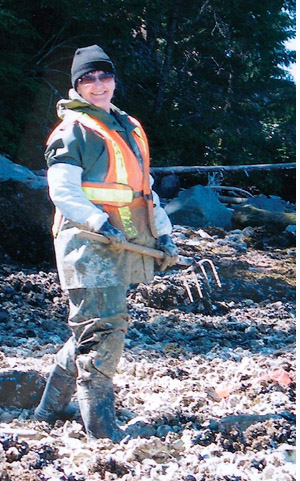 In 1982 I became very curious to see what it was like to spend a winter off the grid. Taking a break from my busy schedule in Victoria I came for a winter visit and, you guessed it, I never left. I met up with my summer childhood friend and we married.
In 1982 I became very curious to see what it was like to spend a winter off the grid. Taking a break from my busy schedule in Victoria I came for a winter visit and, you guessed it, I never left. I met up with my summer childhood friend and we married.
Along with my grandmother, who was 80 at the time, we set up housekeeping on our Blind Bay Island. My grandmother loved Island living, was very helpful and good company.
Our main problem was devising a way to make money. We came up the brilliant idea to farm the water around the Island.
In 1984 we opened a small fish farm and oyster lease-a mom and pop operation for sure. We had 20,000 Pacific salmon and two million oyster larvae which arrived in a coffee filter.
We were naieve but very enthusiastic. We made our own fish pens and nets, hand-fed fish; sorted baby oysters and generally absorbed ourselves into the lifestyle.
It was extremely expensive with the cost of fish feed and so forth. To offset our fish farm habit we took up commercial clam digging. I hated it. Sporting a pair of pink rubber gloves, a miner's headlamp, a garden rake and mop bucket off we'd go. I would hide behind logs and sleep if I had a chance.
Now, 26 years later, I am a passably good digger and I no longer hide behind logs and sleep.
We brought all three of our sons back to the Island and they have had the opportunity to grow up as my husband and I did. My grandma was a terrific nanny and instilled in them a love of Island living and respect for the ocean that remains with them to this day. She would have been around 90.
We managed to keep the lease for 16 years and did eventually learn lots of good strategies for farming the water.
In 2003 my grandma passed away at the age of 98 and we did not renew the lease. It was the end of an era. Her passing left a big gap in our lives and we decided to move to Powell River, the kids already being in public school here.
In 2005 the island was sold for estate purposes, however we still maintain my husband's family home on Nelson Island and the Island on West Lake.
Nowadays, living off the grid, we reflect on how times have changed with the advent of inverter power, cell phones, wireless internet, solar panels, hot water on demand, propane delivery, four-stroke motors and... we love it! It gives us all the more time to sit on the porch and watch the loons float by.
Locating Nelson Island
Nelson Island is the largest in a series of islands located at the entrance to the awe-inspiring Jervis Inlet. It was named after the immortal hero of the British Navy, Rear Admiral Sir Horatio Nelson.
Nelson Island is approximately 20 kilometres long. It has no formal roads but it has a web of logging roads that allow one to move around on some parts of the Island. Although the power lines that connect to Powell River and the mainland cross Nelson Island, the homes there are not connected to the grid.
Wild women cycling
Club offers exercise, friendship and fun
By Isabelle Southcott
Born to be wild or ride to be wild?
A group of women cyclists in Powell River love nothing better than to ride hard, have fun and get dirty!
Leta Burechailo started the Wild Women Cycling Club last year because she wanted to ride her bike in the woods and have some company while doing it. Nancy de Brouwer joined not long after and says she's met some great women through the club and they have fun together.
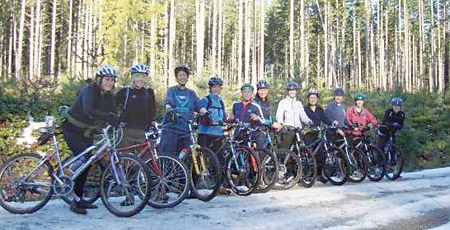
"We're a small group of women interested in riding on the trails. We usually ride once a week in the winter," explains Burechailo.
An email is sent out a couple of days before a scheduled ride to everyone on the list outlining the ride. "Whoever shows up, shows up. We usually have seven but there can be anywhere between five to 15."
Rides vary in length depending on the route. Cindy Stahl and Wanda Griffioen are also active riders. Stahl has been riding in Powell River for eight years, so she knows many of the trails. "She's our navigational goddess," someone quips.
They generally meet up in Edgehill to begin their ride.
Ages vary between 25 to 50 and riders are at different levels. "It's not competitive. We compete against ourselves, our own fitness levels," says Stahl.
"We cheer each other on, especially through the puddles," adds Griffioen.
 The club offers women a chance to get away, socialize and exercise. It's a great way to meet new people and riders feel empowered when they accomplish a new goal.
The club offers women a chance to get away, socialize and exercise. It's a great way to meet new people and riders feel empowered when they accomplish a new goal.
"You don't know you're getting exercise because you are so focused on the terrain and talking to the person in front of you about kitchen renovations. Then half an hour later your bike is muddy and your water bottle is empty."
You don't need to be a great rider or have a fancy bike to be a Wild Woman. "You should see some of the bikes that come out," says Stahl. "All you need is a functioning bike in working order with fat tires and the will to ride."
The groups meets all year long-snow, rain or shine.
With the days getting longer, it will soon be time to add another ride or two to the Saturday rides. For more information, email wildwomencyclingclub@yahoo.ca.
Blast from the Past:
Texada's Klondike king
Charley "The Lucky Swede" Anderson
By Gary Grieco
Charley John Anderson from Boston, who came to be known as the Lucky Swede, was one of those fascinating characters of the Bonanza and El Dorado days. But periods of his life are still a mystery. What we do know is that Anderson was one of those thousands of gold seekers who came to seek their fortunes in the Yukon. Slight of stature, with a pinched face and a small pointed beard, this 37-year-old Swede was immortalized in Pierre Berton's "Klondike-The Last Great Gold Rush 1896-1899."
Berton states in his epic story of the Klondike, that Charley Anderson, the Lucky Swede "still wearing his little pointed beard, died in 1939 pushing a wheelbarrow at a saw-mill near Sapperton, British Columbia, for three dollars and twenty-five cents a day." Yet, residents of Texada Island claimed the Lucky Swede lived and died on their northern Gulf Island in the Strait of Georgia.
Here was a mystery worth digging into-no pun intended.
Canadian journalist Pierre Berton's credentials are impeccable, and the two historical volumes he wrote in 1958 are still considered definitive works regarding the Klondike. Berton lived in fabled Dawson City until he was 12; but did Mr. Berton's researchers get the Lucky Swede's ending right?
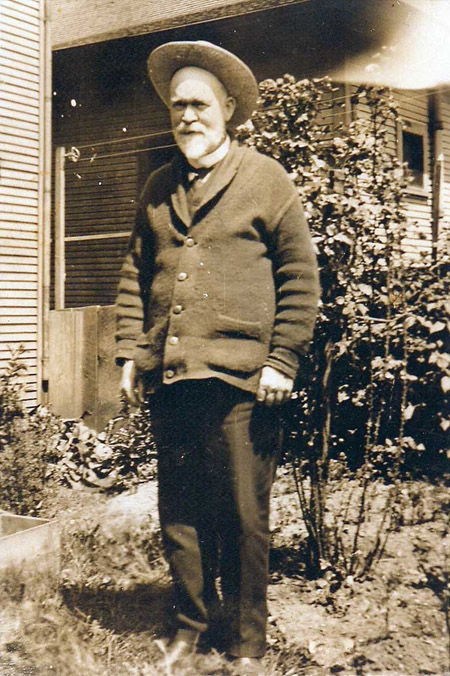
The idea that fortunes could be made in the West and the North has always exerted a magnetic attraction to men, and Charles John Anderson was just one of these desperate adventurers in the late 1800s. Anderson's story of prospecting in the Yukon begins in 1894 in San Francisco. He was one of the thousands of unemployed who were caught in the severe depression called the "Panic of '93" which rocked the American economy, putting prosperous businesses into bankruptcy. The only place left for the wanderers, explorers, and adventurers like Anderson was the great north-Alaska and northwest Canada. Anderson, a 35-year old Swedish farmer, embarked on a harrowing journey over land, sea, mountains, and plains while accompanied by one Englishman and four Norwegians. They froze, starved and suffered a great deal, but finally arrived at an ice valley in the Yukon called Glacier Creek. Anderson slaved for high pay with his disparate partners, digging for gold for a dollar an hour and ending up as a partner in the Glacier Mine. Little did he know that fabulous wealth lay ahead in his future, and that he would become one of the "Klondike Kings."
The legend is that grubstake miners Al Thayer and Winfield Oler had staked out Claim 29 on the Eldorado in the Klondike Valley. Believing it worthless, they returned to Forty Mile looking for someone on whom to unload it. They found 37-year-old Charley Anderson, who had been mining for several years out of Forty Mile, and Oler suckered a discouraged and drunken Anderson out of his stake into paying him $800 for Claim 29. A sober Anderson tried to get his money back, with no luck. Fate played a hand-a million dollars worth of gold lay in the bedrock under his claim. For the rest of his life he would bear the moniker of "The Lucky Swede." Oler, on the other hand, became the butt of so many jokes that he fled the country in disgust, and died in the Pioneers' Home in Sitka, Alaska. He was plagued to the last by the knowledge that he had sold a million-dollar claim for $800 to the Lucky Swede. The Klondike gold fever lasted just two years; from mid-summer 1897, when the news first reached the outside world, until mid-summer 1899, when word from Nome, Alaska of another strike emptied Dawson City. But in that brief period, according to Pierre Berton, "thousands of men lived a lifetime. Those who survived the experience and learned from it were made wise; they had taken their own measure and now understood their failings as well as their strengths. At last they realized that the Klondike experience was as much a quest for self as it was for gold."
Gold fever deserted Dawson City just as quickly as it started. The population dwindled from 30,000 to 5,000 and everyone expected Dawson to crumble into dust like so many other gold-built towns. Somehow it survived, but by this time the Lucky Swede had reportedly taken more than $1 million from #29 above Eldorado in less than four years and headed to Europe, accompanied by his wife Grace Drummond, a former dance hall girl, and the toast of Monte Carlo. Grace had promised to marry the Lucky Swede if he would pay $50,000 into her bank account, and the Lucky Swede was delighted to do just that. The more romantic story is that the Lucky Swede gave Drummond her weight in gold to marry him. The satisfied couple went arm in arm to Paris, London, New York and finally to San Francisco where on the outskirts, the Lucky Swede built a monument to his bride in the form of a turreted castle worth $20,000.
The statistics regarding the Klondike stampede show that an estimated 100,000 persons actually set out on the trail, and fewer than 40,000 reached Dawson. Only about one half of this number bothered to look for gold; of these only 4,000 found any. Of the 4,000, a few hundred found gold in quantities large enough to call themselves rich. These were the Klondike Kings, but out of these fortunate men only the merest handful managed to keep their wealth.
Charley Anderson, the Lucky Swede, fared no better. His dance-hall-girl wife divorced him and the San Francisco earthquake in 1906 laid waste to his wealth since he had invested heavily in real estate. Anderson remained an incurable optimist in spite of these setbacks, and so convinced he would strike it rich again that he vowed never to shave off his little pointed beard until he recouped his fortunes.
This is where the Lucky Swede's history becomes hazy. One source claims he came to Texada Island in 1907 after losing his wife and money, while another has him moving to Van Anda in 1924, with the latter date being more credible. Island history has him working in the Howe Sound area for a few years, mining in the Brittania Mines as well as Sapperton, then coming back to Texada and working in the Billy Slater Mine along with Eddie Raper and Herb Lowther.
Anderson would have felt right at home in the once bustling mining town of Van Anda. At its peak of activity between 1880 and 1919 there were seven working mines with names like Gold Bug, Gold Slipper, Copper Queen and the Little Billie Mine, plus a host of others scattered over the island. In the late 1890s when Klondike fever was at its height, and Charley Anderson was becoming a millionaire, Texada Island was declared the richest 25 square miles in British Columbia. Twin side-by-side cities named Van Anda and Texada City boasted three hotels complete with saloons, an opera house, and three thousand residents, rivalling San Francisco.
The Henry Liebech family donated the Lucky Swede's camera and binoculars to the Texada Heritage Museum. I interviewed Henry Liebech just before he died at age 94, and recorded his memories of Charley Anderson, who lived two doors down in a modest house on Smelter Avenue, now just an empty lot. Liebech reminisced, "He was a small man with a little beard and very affable. He wore mostly dungarees, and I remember him as a ladies man. Charley once told me that it wasn't a million dollars in gold but $900,000."
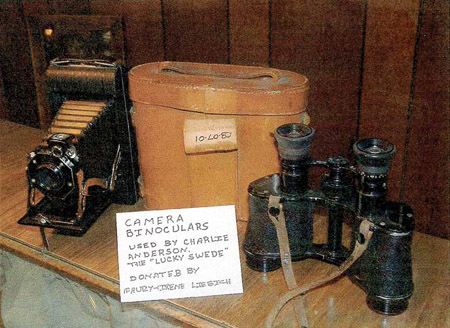
Henry's 90-year-old brother Art Liebech only knew of the Lucky Swede by sight and reputation on Texada. Art was 24 when the Lucky Swede died but he did reveal a fascinating story to add to the Lucky Swede lore. "A native from Sliammon found a rich gold mine towards the south end of Texada. He would come up for years, hammering out just enough gold to support himself for the coming year. He travelled different ways each time so as to not leave a trail. He was smart."
"Charley Anderson and Percy Kirby spent years camped out over the summers looking for this lost gold mine mid island on Texada," recounted Liebech. "Percy was a bachelor and an odd person. He didn't mix very much. I think it was between 1925 and 1930, but they never found it."
Marion Little, now deceased, was the daughter of George MacLeod, a prominent Texada Island pioneer and a great friend of the Lucky Swede. Marion Little remembered him. "He was a small, kind, and dapper man, and the ladies liked him."
The Lucky Swede's sister, Annie Letenoba travelled from San Jose, California to live with him for the last years of his life until he died at 80. On his deathbed, he said to his dear friends and sister, "I've got many good miles ahead of me." He died a few hours later and is buried in Van Anda.

I eventually found the headstone of Charles John Anderson in Van Anda's Woodland Cemetery. It needed attention and I spent some time brushing and cleaning it while thinking about the small man buried under my feet, whose life story was still shrouded in some mystery. The stone read, "In Loving Memory-Charles John Anderson-Klondyke Pioneer." He was born in Sweden in 1859 according to his Death Certificate, and died June 28th, 1939 in Van Anda, BC. Pierre Berton got the date right but the place wrong. Anderson's length of stay in Van Anda as recorded on the death certificate was 16 plus years, which makes the 1924 date about right. But where was he between the year of 1907 and 1924 when he likely left San Francisco and made his way north? A mystery man to the end, the Lucky Swede's death certificate shows his wife's name as Marie Bjornland, with her birthplace as Sweden and not Grace Drummond, the dance hall girl.
Housing, hockey and theatre
Myrna Leishman scores on seniors' housing stage
By Devon Hanley
It's hard to know where to start when talking to former councillor, passionate housing activist, theatre director and serious hockey fan, Myrna Leishman. Down to earth and direct, Myrna gives you the sense that any project she gets involved with, gets done. Recently retired from eight years as a city councillor, Myrna hasn't slowed down. She is president of Sunset Homes Society, an organization that builds housing for seniors, a new board member of Life Cycle Housing and is bodytext into year six as Community Representative for Vancouver Coastal Health. Myrna recently joined the Regional Palliative Care Strategy Committee.
Myrna is also on the board of the Powell River Senior Citizens Association and is in her 20th year as secretary for the North Island Zone Theatre BC. Two decades ago she was one of a group of people who purchased a junior hockey franchise to launch the Powell River Paper Kings, and continued to serve on the board until 2001. "I can't believe I've been to so many hockey games!" laughs Myrna. Her son played hockey, while daughter CaroleAnn inherited her mother's love of theatre; both are members of Far Off Broadway, a group Myrna co-founded with other Powell River theatre enthusiasts.
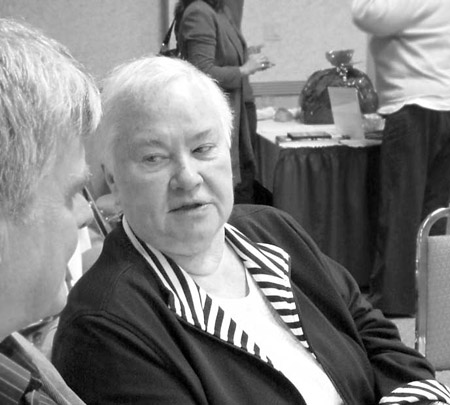
It's clear that community is important to Myrna. While raising a family and working at the mill she did what she had been taught to do as a child-she got involved. "I do what I do because I was brought up this way," says Myrna. "We lived in a Finnish community in Sudbury, and we were dedicated to helping everyone. At 13 my dad grabbed me by the ear and said 'You're the secretary,' so organizational skills come easily to me."
A new initiative that Myrna is passionate about is Solutions for Seniors, a buddy system modeled after successful 'Seniors Links' programs in the Lower Mainland. Volunteers are matched up with seniors who need a helping hand around the house. "The Seniors Citizens Association and Powell River Community Health were concerned about the number of reports of seniors coming home from hospital with no one to look in on them to see how they were doing, or if they needed help," explains Myrna. "Studies show that seniors do better if they can stay in their own homes, but many need a cheerful face, someone to chat with over a cup of tea, and a little help around the house."
The Seniors Citizens Association successfully applied for VCH funding, hired a Seniors Coordinator and Myrna notes the program will be up and running by the end of May. "Seniors are an important part of the fabric of our community. To be isolated and forgotten is hard on people, of any age. Simple steps can change what is a reality for far too many of our seniors. I would like people to realize that being a senior doesn't mean something 'less'." Powell River is fortunate to have seniors like Myrna, and other caring souls who reach out to those needing a little kindness and connection.
For more information regarding Solutions for Seniors please call 604 4149373.
Point of VIU: Boating safely
By Dawn McLean
With the fine weather finally here, Powell Riverites will be excitedly making preparations to ready their vessels for the water. Perhaps that involves checking over the boat, making small repairs, touching up the paint, monitoring the weather - but are you aware of the new regulations that will be affecting small vessels of 10 horsepower or more?
"By September 15, 2009, everyone who operates a motorized pleasure craft must carry proof of competency on board at all times." This regulation has been issued by the Office of Boating Safety, a division of Transport Canada.
Such proof of competency can include taking a boating safety course in Canada before April 1, 1999, or obtaining a Pleasure Craft Operator Card (PCOC). The operator card is good for life, and can be obtained by taking the CYA Safe Boating course at Vancouver Island University this May. Instructed by Paul McIsaac, you will be guided through the rules and regulations, emergency procedures and the theory necessary to operate a power-drive pleasure vessel on both lakes and the ocean. The PCOC card will be issued upon the successful completion of this course that takes place over two evenings.
Feeling pretty confident and think you don't have to take the course? For example: Do you require a PCOC if you are paddling a pleasure craft outfitted with a motor with the motor turned off? What about a sailboat? What if you are a non-resident? The answer to all three questions is "yes" (if the sailboat has an auxiliary motor and if you will be in Canadian waters more than 44 consecutive days or operating a pleasure craft licensed/registered in Canada). Then there is all the information to cover regarding how to respond in an emergency situation, sharing waterways, the safety equipment required and the regulations.... Suddenly, the course looks like a good idea!
You could, however, take the test online. Try www.freecourse.ca. The $25 testing fee includes the taxes and delivery of your PCOC card. You have 45 minutes to complete the exam and must score at least 75%. There are online courses available, but be sure they have been accredited by the Canadian Coast Guard. The list is available at: www.tc.bc.ca/BoatingSafety/providers/acc.htm.
If you do not have the card, you risk receiving a fine of $250. Just think of how many trips up the lake that money could have been used for instead.
Okeover Inlet - Oyster Capital of Canada
Okeover Inlet is just a half-hour drive north of Powell River. Situated at the mouth of Desolation Sound off Malaspina Inlet, the area is known as the oyster capital of Canada. But Okeover is about more than just oysters these days-it is also about shellfish. It's about scallops, mussels, and clams and exotics. Join us as we explore the natural rugged beauty of Okeover, meet the people who make a living from shellfish farming and find out how you can participate in the upcoming shellfish festival May 22-24.
A taste of Okeover
By Isabelle Southcott
Spring sunshine warms my back as I settle myself in Don Carto's boat to begin a tour of Okeover Inlet. As I look at the cottony clouds skittering across a brilliant blue sky, I am reminded again of how lucky I am to have a job I love-a job that lets me see the wonders of our region and meet people I probably wouldn't otherwise meet.
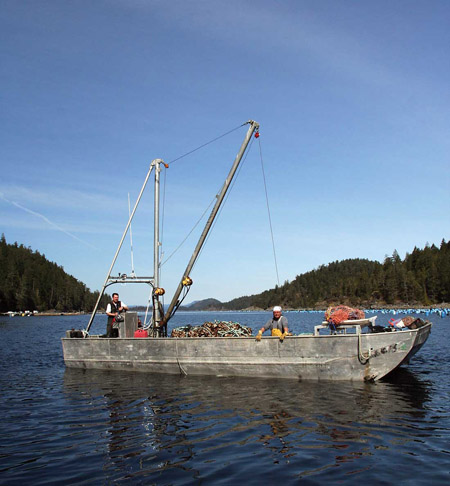
Carto is a commercial diver and president of the Active Malaspina Mariculture Association. He also sits on the board of directors for the Okeover Harbour Authority.
There's a sign at the top of the road that leads to Okeover proclaiming it as the Oyster Capital of Canada but Carto says that Okeover is about more than just oysters-it's about shellfish.
"Shellfish are filter feeders," he explains "and not all shellfish in the aquaculture industry live on the bottom; we have other housings for them."
By other housings, he doesn't mean a skyscraper on Bloor Street in Toronto or an oceanfront home in Powell River, but rather a method of housing oysters, mussels, scallops, and clams as they grow.
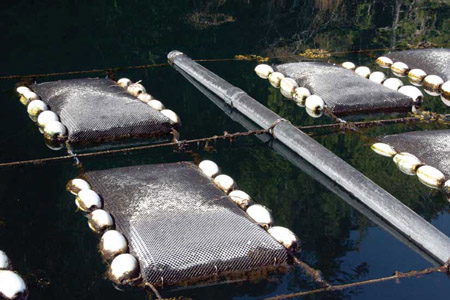
The shellfish industry is a renewable, sustainable industry. Shellfish take in particulates, filter them out and clean the water. The industry is important to Powell River's economy. There are 25 licenses for growing shellfish in the Okeover area alone with 11 licenses in the area owned by Taylor Shellfish, the largest shellfish farming company in North America, with headquarters in Shelton, Washington State. One of the licenses that Taylor bought in Okeover belonged to Chris Day and now he is a manager for the company.
The Taylor family have been in the shellfish business for 125 years and they bought their first lease in Canada in 2003.
"Washington State was always very strong in shucked oysters. They have the shucking grounds in the Olympia Peninsula although they have gradually been going to singles because they are worth more money right now," said Day.
But not everyone is pleased that foreign investors are buying those individual licenses. "There's a worry from some of the old time farmers that they will come in and take over," Carto says, noting that Taylor has its own processing plant nearby, at Fanny Bay Oysters on Vancouver Island. But for some farmers, who are interested in retiring, Taylor has provided them with the opportunity to sell out so they can retire. Carto admits that it is tempting; foreign investors have approached both him and his partner, too.
Growing shellfish involves several different stages, beginning with the purchase of "seed" from a hatchery. It is then brought home and put in housings, which can vary depending on the farmer. "There are china nets, lantern nets and trays," says Carto. It takes anywhere from 12 to 18 months to grow extra small oysters that can be sold, and up to four or five years to produce jumbo oysters.
Carto and his partner Karen King have a shellfish farm called C-King in Trevenon Bay. They have eight licenses and grow oysters, mussels, scallops, clams, sea cucumbers, green urchins, red algae and kelp. They're licensed to grow sea grass but right now they have their hands full doing what they're doing. The couple are the first in BC to do mariculture symbiotically in one spot.
At their farm, they grow nearly one million oysters (82,000 dozen) annually and if everything works out, they are sold for $3 a dozen. But predators, such as starfish (who eat two oysters a day), can really eat into grower's profits.
Although Carto has been shellfish farming for less than 10 years, he says he loves the lifestyle. "I love everything about it. It's really no different than living in town. We have a washer and a dryer and a fridge and a stove and have the same frustrations with Internet and satellites."
They live off the grid and have a power generation system that works off their water supply from Wednesday Lake. Because the Sunshine Coast Trail winds its way just behind their lease, they often have visitors drop in to visit. And while they access their farm only by boat, they are just one hour from the city.
Many people seeking an alternative lifestyle gravitated to oyster farming in this area in the early 1960s. Carto and his partner are now offering shellfish interpretive tours in order to educate people about the industry and offer tourists something else to do while in the area.
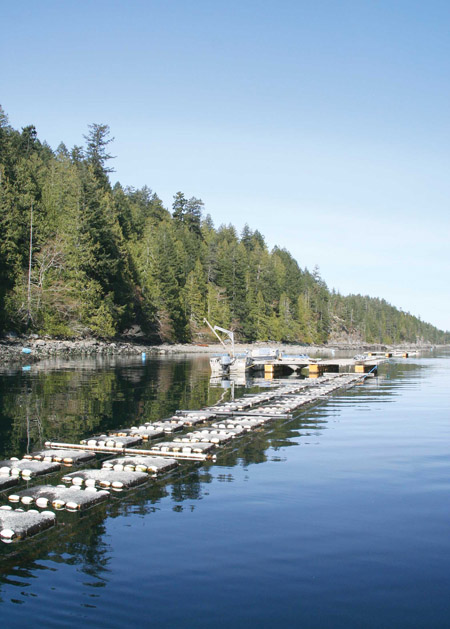
Not far from the government dock is the Grace Harbour Oyster Company Limited. This processing plant is owned by First Nations and managed by Bob Paquin, a well-known name in the industry and one of the founders of AMMA many years ago.
Upon entering the Grace Harbour Oyster Company, visitors are instructed to dip their feet in a bath to remove any impurities.
Paquin is away so his second in command, Mike Williams, tells me about the plant. "We have 10 people working here, six shucking and four sorting."
"The faster you can process your food the better," notes Carto. Williams says you have only 15 minutes to get oysters into a cooler from the time you get them out of the water if the water is over 15 degrees and one hour if the water temperature is under 15 degrees.
The Grace Harbour Oyster Company has six beach leases and their crews work the beach picking wild oysters. They process 200 baskets every two or three days, with 75 oysters in each basket.
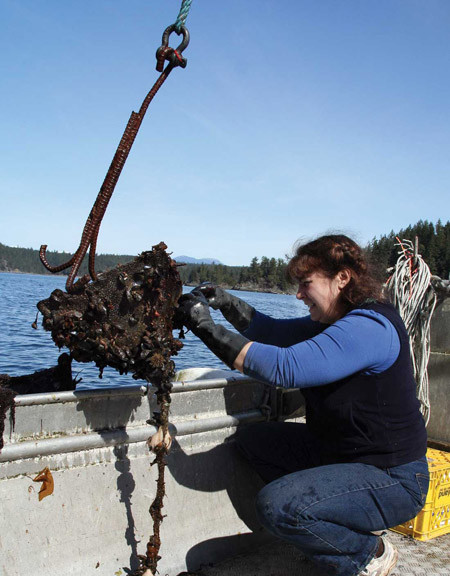
Once the oysters are sorted, shucked and washed, they are put into containers and then jars. From there, they are boxed and sent to wholesalers, mostly in Vancouver, although Grace Harbour Oysters are available locally at Turner Bay Seafoods and The Chopping Block.
Oyster season usually runs from April through to the end of September. Shutdowns depend on what the PSP (Paralytic Shellfish Poisoning) count is. When this count is above 80 parts per million, a red tide warning is issued and shellfish are not safe to eat.
As we chug past Coode Peninsula and into Trevenon Bay, we come to Yves and Ria Perreault's oyster farm. Yves is passionate about oyster farming; Ria runs Little Wing Farm on land. The Perreault's farm is dotted with bouncy bags, a method Yves favours for growing cocktail oysters. The bags are tied between lines and bounce when the waves hit them, which stop the shells from attaching to each other.
Further down the inlet, Taylor Farms employee Megan Doyle is doing some old-style shell setting called culching because the shucker market has started to climb again.
Washington State was always strong in the shucker market but growers gradually grew more singles because they were worth more money. "Now it's beginning to come back," says Day. "And there's every reason to believe the shucker market should be very strong in BC in the next few years but it will take several years to get back to full strength if it ever does."
Automation means increased efficiency in the industry. When a harvester is used, tube clusters of oysters can be stripped quickly so instead of stripping one bag a day the old fashioned way, workers can strip 25 to 30 tubes a day!
Meanwhile, Day says that BC's oyster sales amount to about only three per cent of the world market yet consumers love BC oysters. "There's lots of potential there for growth," says Day, pointing out that the cold, clear, pristine waters grow a top quality oyster. "Other parts of the world are hungry for our product, BC oysters are known as being the best."
"The Chinese market is one of the biggest markets because of their population and the fact that seafood is their number one choice," said King while cooking a seafood feast of mussels, oysters, and scallops served up with homemade bread and a mouth-watering dessert of rhubarb cobbler.
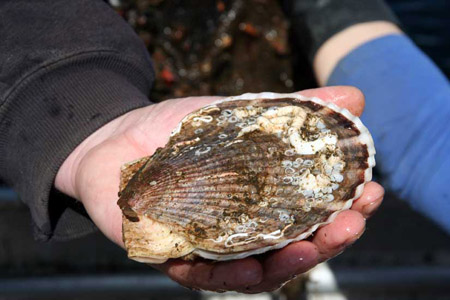
King and Carto are working on marketing their interpretive shellfish tour business. They envision bringing groups of tourists, locals and school children to the inlet to a round pen they will use as a tour station that will house the different varieties of shellfish grown on the farm. Of course, there will be an octopus as no tour is complete without one.
The world is hungry for BC shellfish and with the 2010 Olympics quickly approaching; growers know their products will be in demand.

The industry
Cultured and wild shellfish production rose in value four per cent from $190.7 million to $198.4 million and represented 15 per cent of the value of all BC seafood in 2007. Crab products led the way followed by geoduck clams and prawns with cultured oysters being the fourth largest commodity in shellfish products with $20.4 million in sales and cultured clams next with $11.2 in sales according the BC Seafood Industry's 2007 Year In Review. China is the world's largest and fastest growing seafood market.
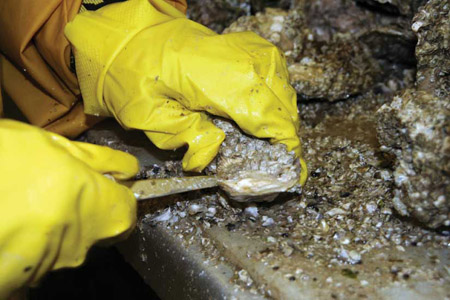
Fresh from the ocean
Al Sharpe and his wife Amy have a special arrangement when it comes to oysters. Al owns an oyster lease in Okeover. Amy owns Manzanita Restaurant. Al supplies Amy with fresh oysters.
"I feel strongly about local food and encourage local production for three reasons," Al said. "It's good for the environment, it's good for the economy and it's good for our health."
Seafood is a specialty at Manzanita and although the restaurant is known for its oysters, scallops and mussels are also offered depending on availability.
When Al and Amy were first married in 2001 they lived in Okeover. Al recalls bringing his new wife to Okeover from San Francisco and how they celebrated New Year's Eve on the beach picking oysters.
Although oyster farmers farm their leases, some also buy seed and load their old oysters shells and any others they have, into a boat and bring them to Pendrell Sound. There, they set their shells to spawn with natural larvae. Pendrell Sound is a south facing sound that has minimal tidal flow so the water is warm. "It's an appealing micro climate for oysters that induces spawning."
Although this method is weather dependent, people have been gathering larvae in this way for years. "The larvae are there so if you set your shells in a favourable place they'll set on your shells," says Al.
Lund Shellfish Festival
Coming May 22-24
Want a taste of what's growing in Powell River waters? Then come out the Lund Shellfish Festival May 22-24.
Last year's inaugural celebration was such a hit, the Lund Community Society, Active Marine Mariculture Association and local Lund businesses are hosting the second annual celebration of nature's bounty and everyone is welcome!
The festival kicks off on Friday, May 22 with the Lund Community Social held at the Lund Community Center at 6 pm.
Saturday, May 23 is Market Day in Lund. Look for music, Sliammon cultural events, cooking demonstrations, oyster shucking demos, arts and crafts, kids' corner and of course yummy shellfish delicacies to nibble on. Don't forget to sign up for the oyster or prawn plant tours being held on Sunday or sign up for a clam digging or Lund historical walking tour.
Sunday, May 24 is Tour Day as well as the shellfish competition-come see the local shellfish farmers compete for the best looking or biggest oyster, scallop, clam or mussel. Tours include a historical walking tour, zodiac tours and kayaking tours. To avoid disappointment, book tours ahead of time. You will also be able to take home live shellfish offered by local farmers.
Come out to Lund and experience a celebration like no other on the peninsula! For a full schedule of events and contacts for booking tours, visit the web site, lundbc.ca or lundcf.org.
Hot Masala Oysters
Ingredients
- Cleaned Oysters - 1 dozen large
- Turmeric powder - 1 tsp
- Ginger - diced 2-inch piece
- Garlic pods - 8 to 10 small ones
- Black Pepper - 1 tbsp
- Red onion - 1 chopped
- Green chillies - A few
- Fennel seeds (Perinjeerakam) - tsp
- Grated coconut - cup
- Cumin seeds (Jeerakam) - tsp
- Curry leaves - A few
- Salt - As required
Preparation
- Cook oyster meat together with little turmeric, little bit of ginger, lots of pepper, 5 cloves of minced garlic and salt on low flame without water until all the natural water in the meat disappears.
- Fry the red onion, green chilly and rest of the ginger, little coconut chops & fennel seeds separately.
- Now add the cooked oysters into it and sautée.
- Grind rest of the coconut, remaining turmeric & garlic and cumin seeds in a blender. Do not grind to a paste
- Add this to the above and sautée.
- Add curry leaves, (available at the Golden Gate Variety store on Marine) along with the fennel and cumin seeds.
Savour the flavours-Shazam! Nice and spicy. Have yogurt, crème fraiche or sour cream if cooling is needed.
Recipe courtesy of Manzanita Restaurant
OYSTERS ROCKEFELLER
Serves 4
Ingredients
- 2 dozen oysters on the half shell, drained
- 4 pans rock salt
- Rockefeller Sauce
- 1 cup butter, softened
- 1 cup cooked spinach, finely chopped
- cup green onions, chopped
- cup fresh parsley, chopped
- 2 tbsp celery, finely chopped
- salt & pepper to taste
- tsp marjoram
- tsp basil
- tsp cayenne
- 2 tbsp Pernod (optional)
Preparation
- Combine all the ingredients. Form into oval patties about 2 tbsp each.
- Preheat the rock salt.
- Place a pattie on each oyster on half shell. Place shells on rock salt.
- Bake in 450¡F oven for 15 minutes until the sauce bubbles and is slightly browned on top.
- Allow to cool for about 5 minutes before serving.
Recipe courtesy Allison Coburn, Turner Bay Seafoods
Harvesting seafood
"When the tide is out, the table is set."
This First Nations saying refers to the many species of shellfish that come into view at low tide. In Powell River you can find everything from oysters clinging to rocks, to clams buried beneath the sand, to mussels and scallops. However, before you head off to pick oysters off the beach, you must get a license.
Licenses are available at many retail locations. For more information visit Fisheries and Oceans Canada office at 7255 Duncan St, Powell River or call 604 485-7963, or try the website at www.dfo-mpo.gc.ca.
You might also want to pick up a copy of Rick Harbo's A Field Guide to Seashells & Shellfish of the Pacific Northwest from Harbour Publishing. This great little guide is filled with fun facts and is a good resource for beachcombers of all ages.
The Okeover dock
Keeping the dock at Okeover in good working order is important for those who work thewaters in the area and for pleasure boaters alike. The Department of Fisheries and Oceans recently funded $600,000 on upgrades and locals say that people from Powell River aredriving out to Okeover to launch their boats now.
Getting oysters and shellfish to a processing plant as quickly as possible is important anda good dock is all part of the picture.
Mother's Day story winner: Why my Mom is the best Mom ever!
By Jennifer Powell
First, in order to get you to understand why my Mom is the "best Mom ever" you need to know a little history behind our family.
My mother grew up in Powell River in a very large family; she has nine brothers and sisters. They didn't have a lot of material luxuries, however they made up for it with lots of love and compassion for others. After finishing high school she worked a lot and eventually met my father. They got married and started thinking about kids. First I was born, then my little brother four years later. This was an exciting time for the both of them; however after a plane crash my father passed away before I turned four years old and before my little brother was one.
My mother, a woman with an amazing spirit and an amazing drive in life, was very distraught but with two young children to feed and a life to live she continued on. Whenever I talk or tell anyone about my childhood I have nothing but good things to say. Why? This was due to my amazing mother! While most other students in my classes had two parents I had only one, but I still had someone there for me cheering me on or taking me and all my friends camping, hiking, and bowling or just for a big bonfire and party on the beach. I don't ever remember a time when my mother missed something that was important to my brother or me. She even was my baseball coach and main supporter at all my soccer games.
We moved to Victoria for a while and she was rear-ended by another driver and lost her job due to being in so much pain that she would cry at her desk but not let anyone else see. Even then, she still made sure we were at every swim practice, every baseball game or whatever we had going on at that time. She ended up going back to school and because it was too expensive to get a babysitter my mother would take us with her and we would cheer her on for every exam or test that she had to do.
She did more for us as a single mother than most of my other classmates got out of their two parents! Not only did she help us through growing up, getting over the trials and tribulations of youth and high school, but she also took time to grow herself. My mother is an amazing businesswoman who works very hard to grow her business and she even gives back to the community. On top of all that she has worked at the college and with Simply Accounting to improve the knowledge of others and to improve the teaching of Simply Accounting by editing their manuals.
I can't stop here as she is not only a businesswoman but also an adventurer, great friend, caregiver to my grandma and grandpa and just a loving outgoing woman who is not afraid to speak her mind and tell it like it is. My brother now lives in Virginia, works as a civil engineer and is married and very happy; while I live in Calgary and am working towards finishing my CMA and helping out in the community and with a handful of charities. The strength, determination and unconditional love my mother has always exuded to others has made me very proud to be her daughter, best friend and admirer. All in all I believe, no, I know, my mother is the "Best Mother Ever" and even if she doesn't win this contest she has won over anyone who has met her.
Jennifer Powell's story about her loving mother is the winner of our "Best Mom Ever" contest. Jennifer gets to take her mom, Geri Powell for dinner at the Manzanita Restaurant and for a pedicure at Cream and Sugar, courtesy Powell River Living.
For Art's Sake: The classical music scene
By John Silver
Powell River's classical music scene has been as busy as ever since my article in the Winter issue of Powell River Living on the then forthcoming visit of Ballet Jšrgen Canada. The live ballet was a great success (more below), Max Cameron Theatre has presented live, high-definition broadcasts of five operas from New York's Metropolitan Opera (the "Met") and the Academy of Music has had two concerts and the unveiling of its new piano.
Jacquie Dawson, Manager of the Max Cameron Theatre at Brooks School, took quite a risk in booking Ballet Jšrgen Canada for a live performance on stage at her theatre. Failure to attract a good audience would have punched a deep hole in her budget. Happily, her faith was justified and a sell-out audience gave the ballet company's 16 artists long and loud applause at the end of the performance of Prokofiev's Romeo and Juliet.
The set and lighting designs by Glenn Davidson were highly effective with a small number of arches easily moved to create the different scenes. Costumes by Gary Dahms were quite sumptuous for the big settings in the Capulet home and appropriately simpler for the crowd scenes in the streets of Verona.
I assume the company rotates the dancers in the roles of Romeo and Mercutio. For the Powell River performance, Romeo was danced by Hampus Gauffin and Mercutio by Preston McBain although the poster publicizing the ballet appeared to have the latter as Romeo. Technically both dancers were excellent but Gauffin was somewhat lacking in passion. This was most apparent when Gaufin was opposite Tara Butler who gave a luminous and compelling portrait of Juliet.
Choreography was by the company's founder and artistic director, Bengt Jšrgen, who took the role of Tybalt and was particularly memorable in the fight scenes with Mercutio and then Romeo. All other aspects of the presentation, such as the lesser solo parts and the ensemble pieces, were of the highest standard.
The five Met operas spanned premiere dates from the latter half of the 18th Century to the second decade of the 20th Century. La Rondine is not one of Puccini's most frequently presented operas but has been championed recently by husband and wife opera stars Angela Gheorghiu and Roberto Alagna who were the principal singers. Gluck's Orfeo ed Euridice was given a contemporary setting which satisfied some in the audience but was not to the liking of others. The music, however, received universal acclaim with a breathtakingly beautiful performance of Orfeo by American mezzo-soprano Stephanie Blythe.
Donnizetti's Lucia di Lammermoor was moved effectively from its original 18th Century setting to the mid-19th Century by director Mary Zimmerman and starred Anna Netrebko as the doomed title character. Zimmerman also directed Bellini's La Sonnambula which she chose to present mostly as a company rehearsing the opera. Critics had called the production "a travesty" and most in the Powell River audience certainly were not favourably impressed. Fortunately the production was redeemed by outstanding singing from Natalie Dessay and Juan Diego Fl—rez.
The biggest audience (almost 200) of the opera season was found at Puccini's Madama Butterfly. This beloved opera was directed originally by the late Anthony Minghella who presented a combination of western and Japanese elements in a gloriously costumed production. Of special note was the use of a puppet, operated by three puppeteers, for the three-year old child of Cio-Cio-San (Madama Butterfly). This writer and many in the audience found the skill of the puppeteers translated into a moving and convincing portrayal of a child character. Some, however, could never remove the puppet itself from their minds.
The Academy of Music's two concerts as of copy deadline were Trio Voce (Jasmine Lin, violin, Jennifer Hoover, cello, and Patricia Tao, piano) in a program of music by Part, Tower, Rachmaninoff, Brahms and Piazzolla and a welcome return of the Pacific Baroque Orchestra which once again performed in a combined program with the Academy Chamber Choir. By the time you are reading this, the Academy Chamber Choir will also have featured in a May 2 concert with Chor Musica Men's Choir.
The other exciting event at the Academy was the first occasion the new Steinway concert grand piano was in performance. Those lucky enough to attend heard an extraordinarily fine instrument which will further enhance the reputation of the Academy and undoubtedly attract musicians of international calibre for future concerts.
For the first performances, those playing ranged from one of the youngest students at the Academy, a young man who needed a step to be able to gain his seat on the piano bench, to established faculty. After the performances, those in the audience were invited to try the instrument for themselves. It is not every day that music enthusiasts with little or no piano playing skills are able boast of having played a Steinway!
TC Mall expansions: Major renovations show commitment
Shopper's Drug Mart has begun work to more than double its footprint at the Town Centre Mall.
Jack Barr, one of the mall's owners, announced the expansion at a recent presentation to Town Centre tenants.
Shopper's currently has 8,000 square feet, but plans to move into an expanded 18,000 square-foot space across the mall. The store will occupy the space from Tomato Rice to where Carol's Boutique used to be-that's 200 feet of mall frontage. It will push the new front 25 feet into the mall parking lot, adding two entrances to the mall. The ceiling will also be raised 10 feet.
The expansion will spark some changes to the parking lot. A sidewalk will be extended to Barnet, and pedestrian corridors created through the parking lot. A three-way stop will be set up near the entrance to the Staples complex from the mall. Bus routes and stops will also be changed around the Town Centre.
Other changes inside the mall have already been started and more are in the works.
The RCMP community office has moved down the mall to the spot beside Split Endz. That allows The Source to double in size. An upgrade to Suzanne's is coming in August. Armitage Men's Wear will move to a larger space where Work 'n Play used to be.
"Wal-Mart has committed until 2016, and they're planning a renovation similar to what was done with the Save-On-Foods. All our anchor tenants are committed long-term," said Barr.
That certainty has prompted some other upgrades, too. Painting, lighting and entrance doors are being updated.
"The mall was built in 1980-82 and it's tired. We need to update it," said Barr.
The announcements were met with pleasure by tenants and Mayor Stewart Alsgard.
"Times are tough everywhere. Tough times don't last, but tough people do," said Alsgard, who commended the Town Centre for helping create growth in the community.
Town Centre businesses employ 780 people.
Bruce Denniston Bone Marrow Spirit Run
Event has something for everyone
by Jerry Causier
I have to be honest. I didn't start out as much of a runner; I'm still not really. Someone early on in my running evolution asked me what my running style was and the only thing I could think to answer was a sheepish, "Um, persistent?" For those of you thinking of starting a running or walking program (no matter what your style or level of fitness) the Bruce Denniston Bone Marrow Spirit Run has something for you.
I think I've always tried to be in decent shape but it wasn't until about five years ago that I started purposefully running. I remember that my first run was not a particularly pleasant experience. I had a nearby destination in mind and even though I was relatively fit, I didn't really enjoy striving for that first goal. But I did it. The next day I tried it again and to be frank, I didn't feel any better- but after consistently committing to running a little bit more each time I went out (I aimed for four days a week), I was genuinely impressed with how much better I was getting. Even now I will probably never win a marathon but I'm okay with that because all I really want to do is stay healthy, enjoy myself and maybe perform a little better than I did last time.
One of the most powerful training tools I developed early on was goal setting, and one of the first goals I set was to participate in the Annual Bruce Denniston Bone Marrow Society Spirit Run. One of the great things about this event is it has a potential challenge for everyone, from the casual walker to the elite marathon runner. This year's event is May 30. There are 5K, 10K and half-marathon routes for individuals or you can get a group of four friends together and motivate each other to complete the 20K relay.
The Spirit Run has been happening for nine years and is a great opportunity for people to do some physical activity in a beautiful setting (the courses start and end at Willingdon beach and take you along the Willingdon beach trail and/or the seawalk depending on what distance you sign up for). It also raises funds for a national organization based right here in Powell River. The Bruce Denniston Bone Marrow Society provides funding for bone marrow related causes and also provides funding directly to patients and families to offset the incidental costs of treatment.
This event is a perfect choice if you're interested in improving your physical fitness, while enjoying a scenic route and raising money for a local charity. For more information on the society and the event go to www.dennistonsociety.org or call the office at 604 4858488.
Tips for the new runner and walker
by Stacey Causier
As a Certified Personal Trainer, I work with people from a wide variety of fitness levels. A common misperception of people just starting out on their fitness journey is that it must be somehow "easier" for people who are in good shape to maintain their level of physical activity. It's important to realize that even people who are in great shape sometimes struggle with getting motivated.
Getting up early to go to the gym, going for your walk or run when the weather isn't great, or making sacrifices to maintain a healthy weight isn't "easy" but the pay off is well worth it.
Often the hardest step is getting started-so put on your running shoes, skip watching another reality show and go for a walk or bike ride, or make that healthy eating choice. Remember that you can either make time for health now or make time for illness later.
Race Day Recipe
The following recipe can be found in the new Bruce Denniston Bone Marrow Society fund raising cook book. You can pick up a copy of this cook book that's filled with lots of ideas for healthy meals, snacks and drinks from the Bruce Denniston Bone Marrow Society office. Here's one to get you started:
Loading Zone Breakfast Drink
A perfect pre-run charge-up
- 2 tbsp Honey
- 2 tbsp Wheat germ
- 2 tbsp Lecithin
- tsp Vanilla
- 1 cups Milk or Fruit Juice
- cup Yogurt
- Banana or other fruit to taste (frozen blackberries, peaches etc.)
Mix well in a blender and drink a cup half an hour before activity. Save the rest for a quick snack after your activity.
Business Connections
By Kim Miller
The Chamber of Commerce is working on a shop local program. We are encouraging all residents to keep their hard-earned dollars in the community. Watch for more upcoming shop local promotions as we partner with Powell River Regional Economic Development Society to establish a shop locally campaign.
We are also asking everyone to spruce up the outside of their homes, store fronts and shame their neighbours into doing the same. A beautiful community is a happy community. An open house on beautification is coming up Tuesday, May 19 at 7 pm in the Evergreen Theatre. We invite everyone to attend and hear about the initiatives already under way, how you can get involved, and how we can all help encourage our civic pride. This is a partnership between the Chamber and the Powell River Parks, Recreation & Culture department.
There is a new menu and a new director of operations at the Savoury Bight Seaside Restaurant & Pub at the Beach Gardens. Joe Rizak has 28 years experience in the food and beverage industry, including high-end restaurants, nightclubs, and a catering business. Most recently, he comes from Cioppino's Mediterranean Grill in Vancouver. He was recruited to join the Savoury Bight after doing some consulting work for the year-old restaurant and pub. The Savoury Bight's new regular menu boasts lower prices and visitors will also find a more expansive fresh sheet. A bigger wine list and a huge selection of martinis are also some of Joe's additions.
Congratulations to Heather Tours for celebrating their fifth anniversary in Powell River. Due to recent regulation changes with the Business Practices and Consumer Protection Authority in Victoria, travel agencies are now allowed to be home-based, so Janice Olfert has moved her business home! Call her at 604 483-3345. Check out all the great tours available at www.heathertours.com.
Andy's Powell River Services, owned and operated by Andy and Donna Seward, is providing in home appliance repairs and full warranty service for all the major stores and manufacturers. Donna grew up in Powell River and Andy hails from Vancouver. They returned here because they knew they wanted to raise their children in Powell River. "We have both always worked in customer service oriented businesses and we truly believe that our great reputation for honesty and good service will continue to keep the business thriving," says Andy. They are already hoping to expand by hiring another technician to do any natural gas work. You can contact them at 604 483-9773 or by email at andysprs@ymail.com.
For over 80 years Investors Group Financial Services has been providing personalized financial planning for our area. The company has moved to their new offices at 200, 4801 Joyce Avenue in Crossroads Village. Call them at 604 485-2552.
My friend Jessica Medford told me five years ago that her dream was to own and operate her own grooming business. She recently made her dream come true! Grooming by Lou Anne is now operating as Dog Gone Grooming & Boutique under Jessica's ownership. The business offers expanded services including Sunday service by appointment. An enhanced product line was recently introduced and has been a hit with new and past clients. Former owner, Lou Anne Kerr, and employee Lexi Smith continue to work with Jessica in the business.
New business owner Sean Melrose told me everyone knows him as the new doctor's wife. I told him I wouldn't emphasize that fact, instead I would focus on him. Sean moved to Powell River with his wife (yes, new doctor in town) and their baby last fall. He now operates two new businesses under his ownership. Beacon Wealth Management is a full-service investment advisory firm, helping their clients build lasting and profitable portfolios. Georgia Strait Capital Stewards offers comprehensive financial planning, from tax planning and asset allocation to insurance analysis. From Gibsons to Powell River and Nanaimo to Campbell River, they can engage clients on a fee basis or provide their advice as added value with their insurance and investment solutions. Sean is located on Marine Avenue beside The Cut hair salon. You can call him at 604 485-5256.
The new owner of The Boardwalk Restaurant in Lund is Trent Tope. He has relocated here from Wyoming and already loves this area. His family background is ranching, hotels, lodges and restaurants. They own a couple such businesses in Alaska and Montana. His parents are joining him soon to operate the restaurant. He says he will feature mostly seafood specialties.
The Volunteer Centre & Powell River United Way have combined office spaces and jointly hired an office manager, Dale Lawson. A community impact coordinator, Janet Alred, has also been hired to help spread the word about the great work both organizations do in our community. The office is now located above Rona. Call 604 485-2132.
Do you have any changes within your business you want Powell River to know about? New managers, new owners or are you moving locations? Starting a new business? Call the Chamber office at 604 485-4051 and I will get your info into the next issue of Powell River Living.
Patrons promise to promote Powell River
Festival of Writers set to grow
By Gary Grieco
The Festival of Writers could soon get a whole lot bigger.
This small, but quality driven yearly conference has been responsible for providing Powell River's professional and aspiring writers with learning experiences with some of Canada's top literary talent.
This year's presenters Sylvia Taylor, president of the Federation of BC Writers, and Anthony Dalton, world adventurer, author, and president of the Canadian Authors Association, were so impressed with the talent and enthusiasm they witnessed at the March festival, that they offered to act as patrons for future festivals.
"This festival has such great potential," Dalton explained to President Barb Rees. "You have location, great weather, and the friendliest people. We will talk it up across Canada and help you organize."
"We want you to be a victim of your own success," echoed Sylvia Taylor.
Students at Brooks Secondary and Oceanview Middle School were again included in this year's festival writing contest, and benefited from the expertise of presenters Dalton and Taylor who worked with them. "These are the future writers of Canada," said Taylor. "They have to be supported or we lose that creativity."
Winners were recognized at the schools and awards presented.
The public library hosted author and educator Sylvia Taylor and she spoke to 40 eager people about "Writing Your Life Story." There was a full day of writing workshops with Dalton and Taylor sharing their knowledge and experience; followed by a banquet, then a silent auction with items donated by Powell River's business community with partial proceeds going to the CAT Scan fund.
Barb Rees' dedication and talent have paid off. With the added prestige and strength of Dalton and Taylor backing the festival organization, the prospect is very real that Powell River could become a yearly destination for writers from all parts of Canada.
Time to plant
With horticulturist Jonathan Van Wiltenburg
The flowers promised by the showers of April are upon us and the garden beckons.
May is a transition time in the garden because you are never quite sure whether we are finished with frost or not. "The general rule is that we should not get a frost after the May long weekend," says horticulturist Jonathan Van Wiltenburg.
Before you dig, fortify the soil with leaves or seaweed or compost you've been working over the winter.
If you're into food gardening, it's time to get your seedlings ready to move outside after the threat of frost has passed. At this time of year, you are continuously seeding both inside and outside at the same time.
Carrots, beets and parsips can be planted directly in the ground. After the long May weekend, plant pole beans, zucchini, tomatoes and anything that likes warmer weather.
When moving transplants, make sure you put a shot of compost into the hole. Don't cover the crown of transplants - the one exception is tomatoes, especially if they're tall and leggy, as you'll want them well rooted.
Jonathan suggests that first timers start with tomato plants planted up against the house underneath the eves if possible. Lettuce is always popular and there are some great mixes available these days. There's nothing like a sweet carrot from your own garden and potatoes are super easy to grow. If you have room, broccoli is a sure winner and once you've grown your own fresh herbs you'll never want to use dried ones again! Oregano, thyme and rosemary are perennials so these three are especially low maintenance.
Peas that were planted in March will be ready soon and if you have rhubarb growing, it will be ready too. And don't forget to pick the asparagus!
Jonathan Van Wiltenburg has a degree in horticulture and runs Eden Horticultural Services. He trained as a gardener at Butchart Gardens. Contact him at 604 483 6053 or edenmaintenance@gmail.com.
A Gardener'sBasic Toolkit
- Sharp spade
- Stirrup hoe
- Leaf rake
- Pruners
- Stainless steel trowel
- Green thumb (optional)
Pardon My Pen: The inconsistency of English
By George Campbell
If the plural of mouse is mice and the plural of louse is lice, how come the plural of house isn't hice? If the plural of goose is geese, shouldn't it follow that the plural of moose is meese? One should be able to walk into a real estate office and say, "Have you got any hice for sale where I can look out the window and see a herd of meese?"
Some of our English words just plain don't make sense. Take the word 'butterfly.' A housefly is so called because it hangs around houses. The same thing applies to the deer fly and the horsefly in that the former hangs around deer and the latter hangs around horses. But a butterfly doesn't hang around butter, so how come it's called a butterfly? The way this little insect flits from flower to flower it should be called a flutterby. Watch one and see if you don't agree.
If you put the prefix 'in' in front of some words it changes the meaning of the word to the exact opposite. Audible becomes inaudible; capable becomes incapable; decent becomes indecent; and consistent becomes inconsistent-just like the English language. But, if you put that same prefix in front of the words candescent and flammable, it changes nothing. Incandescent and candescent both mean the same thing. Ditto for flammable and inflammable. So, why bother putting 'in' in front of these words? All it does is take up more time and use more space.
The sounds oh, oo, aw, ow and uff are all spelt the same in the English language; 'ough.' Repeat the following words to prove it: though, through, thought, bough, and rough. This is not just confusing; it is downright chaotic.
Most words containing the letters ea rhyme with beer. Words like ear, fear, dear, clear, and appear. But how about pear, bear, tear, and wear? They rhyme with air, proving yet again the inconsistency of our language.
Some English words have superfluous letters in that these letters are not pronounced when using the words in speech. Words like: psychiatry, psychology and pneumonia. The p in these words is silent, just like it is in swimming. And how come abbreviation is such a long word? Also I'd like to know why phonetics isn't spelt 'foanetix' because phonetically that's the way it sounds.
The nuances and subtleness of our Mother Tongue create problems for people from other countries attempting to use the language correctly. They often end up saying something entirely different from what they intended. The following are some examples.
Sign in a cemetery in Sweden: "People are prohibited from picking flowers from any but their own graves."
Notice in a hotel, Zurich, Switzerland: "Because of the impropriety of entertaining guests of the opposite sex in the bedroom, it is suggested that the lobby be used for this purpose."
In a cocktail lounge, Norway: "Ladies are requested not to have children in the bar."
Sign in the window of a Laundromat, Rome: "Ladies, leave your clothes here and spend the afternoon having a good time."
Notice on hotel room door, Kyoto, Japan: "You are invited to take advantage of the chambermaid."
Ahh, the vagaries of the English language. The gh at the end of enough is pronounced eff. The y in the middle of physical is pronounced i as in it. And the ti in the word nation is pronounced sh. It therefore follows that the proper spelling of the English word 'fish' is ghyti.
No wonder people from other countries have trouble with our language. I've lived here all my life and I have trouble with it myself.
Family Matters
By Isabelle Southcott
Stages & phases
How do you handle the changes that occur as your child grows into an adolescent?
As rewarding as parenting is, it's certainly not easy. I've always been amazed that the government either legislates or licenses everything from drinking alcohol to driving to operating a motorboat but when it comes to children your only requirement is procreation.
I still remember when I took my first child home from the hospital 12 years ago this Mother's Day. My father had warned me that caring for a baby was quite different than looking after a horse and was he ever right!
To say I was scared and nervous of caring for this precious baby was putting it mildly but we learned and muddled through. I think every parent wants to be the best parent they can be. It is just that some, for whatever reasons, are better equipped than others. When your child is a baby you make the decisions for him or her. He may not like what you decide, and believe me he'll let you know. Still, you don't have a two-way conversation with an infant. As your child grows, so do you; yet you still don't let your three-year-old make his own decisions. Remember what it's like trying to reason with a toddler?
Relationships evolve and bit-by-bit your child will express his wishes and desires more and more. They may not always be suitable but still, he is having his say. It might be about a hairstyle (that you don't like) but is this issue really your hill to die on? Or that ratty purple shirt he insists on wearing all the time?
When I was being particularly difficult my father would announce that "Isabelle is going through another phase." I think I went through at least 40 phases.
The same holds true with my own children. They are going through many phases, some wonderful, some not so wonderful. My relationship with them has been a delight, a privilege and yes, sometimes, an exercise in frustration as they grow. We teach our children to become independent and gradually they do, but in the process we worry that they will not make the right choices. Hopefully we will have done our job properly and the basics will be in place so they make the right choices.
This letting go but being in the wings to catch them if they fall is another stage for me. I am learning, as my children are, but through it all I insist we always communicate. I am willing to let them explore and try new things if I know what they are doing and who they are doing it with. It is when I don't know that I worry.
Get involved and help out
At first the volunteering was not quite so voluntary. When Bernie and Regina Vecsey realized one of their sons was having problems at school, they began helping out.
Their son, in Grade 1 at the time, was later diagnosed as having severe dyslexia, which meant he had great difficulty in recognizing the written word. At the time, most educators didn't know a lot about severe dyslexia.
"At first, it was downplayed as behaviour problems," and the Vecseys were told their son just had to try harder.
"So my wife and I were at the school almost every day, helping him succeed. I soon realized there was so much you should do and that teachers, especially those with big classes, need support," said Bernie.
That was back in 1994, soon after the Vecsey family moved to Powell River from Ontario. Although Bernie didn't know it at the time, the seeds had been planted for him to take the Support Services Worker Certificate Program.
From then on, whenever help in school was needed and the shifts at work permitted, he volunteered. Sometimes it was once a week helping out with the Grade 3 reading group, other times, it was helping out twice a week with the morning cross-country run.
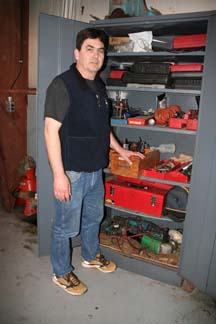 For Bernie, it always has been, and still is, important to get involved in community or school.
For Bernie, it always has been, and still is, important to get involved in community or school.
Bernie recalled a time when his oldest son was listening to the folk song Cat's in the Cradle, by Harry Chapin, and it seemed that the son in the song was challenging him in a funny way about his involvement in his own son's life.
The song talks about a child being born and how the father was busy making a living. "But there were planes to catch, and bills to pay. He learned to walk while I was away."
As Bernie listened to the lyrics he knew he didn't want to miss his children growing up and so he vowed to become an involved parent and spend as much time with his family as possible.
It was challenging because Bernie worked out of town for several years and was home only on weekends.
So when the opportunity arose for him to retrain, he took advantage of it and took the Social Services Worker certificate from 2000 to 2002, while working on-call for PRACL.
It was this helping hands attitude that led Bernie and Regina to spend hours in the classroom while their four children were growing up. From classroom helper to parent volunteer with the PAC (Parent Advisory Council) and then onto DPAC (District Parent Advisory Council), Bernie has been and still is an involved parent. He was the DPAC chair and during that time attended almost every school board meeting.
"I spent countless hours volunteering," said Bernie. "As long as my kids were in school or involved in any group we helped out."
DPAC is the umbrella organization of the PAC's from each school and usually one representative from each PAC attends DPAC meetings, which the board chair and superintendent also attend. Everyone is updated about what is happening in the district.
"I was the spokesperson for DPAC as chair, vice-chair or as a member of the executive for several years," Bernie explained. DPAC work was interesting for Bernie; he was on the District Nutrition Committee and the "Youth Drug Task Force," and the Brooks Expansion Committee, where he emphasized the importance of the trades in high school. One program in particular parents were advocating for was the Secondary School Apprenticeship Program, which offers the student while in Grade 10 to 12 an apprenticeship, half-time in school the other half in a shop. The difficulty in Powell River was the small number of employers willing or able to take a student on only half-time. The Dual Credit programs are a more successful way to accomplish that.
One thing led to another and during all this Bernie got to know trustees and staff. Bernie remembers when the late Geoff Clarke came up with the BOATT program, and how excited he was about it after several years of frustrating encounters in "Youth Drug Task Force" meetings where other stakeholders did not see a need for young people to have outlets other than organized club activities.
"I recognized the importance of life skills for young adults and outdoors has always been my interest. It's important for students to find some purpose. My argument has always been that we need to offer something else for students in the school besides academics."
Case in point: Bernie has four children, three of whom have already graduated. One is a carpenter; one is an investment banker and the other is studying kinesiology.
Before moving to Canada, Bernie volunteered at youth centres in his native Germany, so he knew how much of a need existed for youth. Support Service Assistants, or educational assistants as they are often called, provide support to students. Three years ago, when the trades program began, a trades assistant was needed. "The combination of my journeyman trades experience and education assistant made me a perfect fit."
Bernie spent two years working with the Brooks Dual Credit welding program and for the last year he has been with the automotive program, and when needed with other elective trades programs in Brooks School.
"I believe a student has to want to come to school and to have fun at school or he won't learn."
When students disengage and tune out they are unable to retain information and won't learn new skills.
"When students learn life skills and critical thinking skills, they are able to deal with any life situation and other skills will follow automatically."
